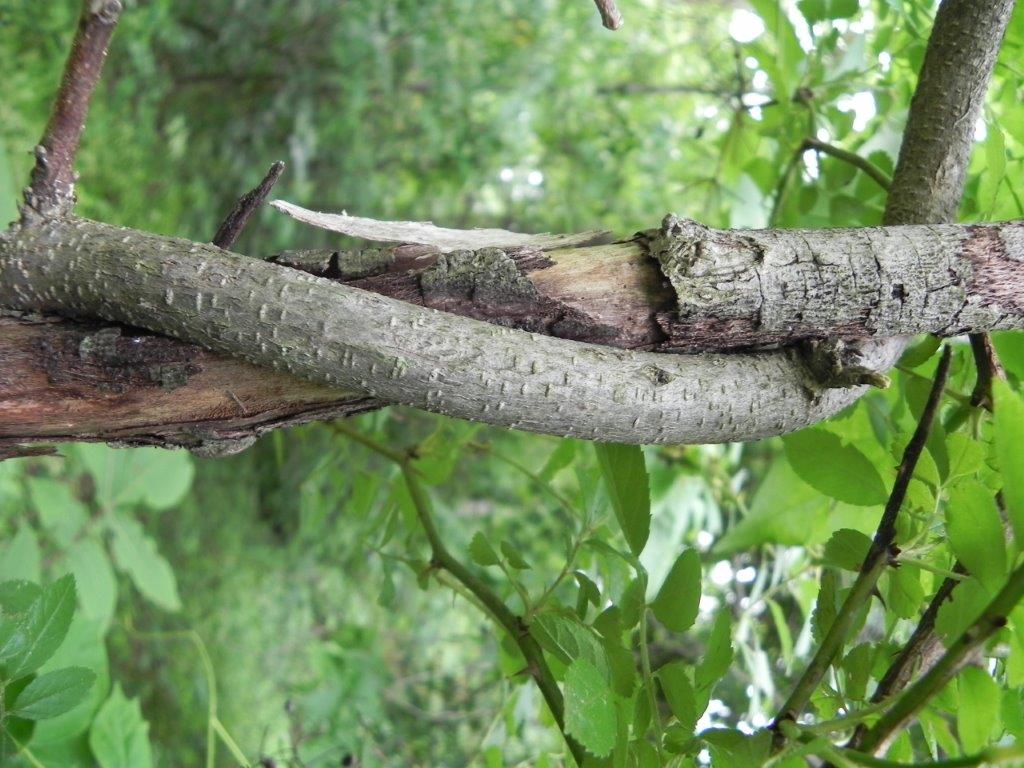Chinese Wisteria
Genus/species: Wisteria sinesis
Description: Chinese Wisteria is a deciduous woody twining vine that can climb up tree trunks to 60 feet or more. It twines in a clockwise direction. Identifying characteristics include compound alternate leaves 6 to 10 inches long containing 7-13 elliptical leaflets with wavy edges that are tapered at the tip. In April flowering occurs before leaf expansion. The fragrant flowers are lavender to purple and occur in long, dangling clusters with individual flower stalks. The fruits are green to brown velvety seedpods 4 to 6 inches long and appear midsummer and persist for a long time on the vine. This vine can girdle a tree and eventually kill it. On the ground it can form dense thickets that smother and shade out native vegetation and impede the native plants. For control of vines climbing up trees, an application of a systemic herbicide to cut surfaces can be applied. For a large infestation, a foliar herbicide may be the better choice. Care should be taken to avoid confusion with our native Wisteria which looks very similar.
English Ivy
Genus/species: Hedera helix
Description: English Ivy is an evergreen climbing vine that attaches to surfaces by way of small root like structures which exude a sticky substance. Older vines may have stems up to 1’ in diameter. Individual plants can grow up to 99 feet in length. Identifying characteristics include a 3 to 5 lobed dark green leathery alternate leaf with white veins. Vines can grow up to 10 years before producing clusters of small, pale yellow-green flowers in the fall. The black-purple fruits contain 1 to 3 seeds. A combination of manual and chemical control is the most effective in control.
Japanese Honeysuckle
Genus/species: Lonicera japonica
Description: Japanese Honeysuckle is a fast growing woody perennial vine that can form a thick ground cover. It climbs by twisting its stems around limbs, trunks or shrubs, fences and small trees. Identifying characteristics include opposite, deciduous leaves that can persist into late winter or early spring. Flowers produced from April through June are tubular with five fused petals, white to pink, turning yellow with age, very fragrant, and occurring in pairs along the stem at leaf junctions. The plant produces small black fruits. The stems of the vine are somewhat hairy with a hollow middle, and can grow to be 30 feet in length. For control care should be taken to remove as much of the root system as possible and all portions of the plant should be removed because the plant can root from small cuttings. Cut stem treatment applied to freshly cut large vines, is effective in areas where vines have grown into tree canopies or other vertical surfaces.
Oriental Bettersweet
Genus/species: Celastrus orbiculatus
Description: Oriental Bittersweet is a deciduous woody perennial twining vine. Its dense foliage can shade out existing vegetation. Identifying characteristics include alternate glossy leaves up to 4 inches long which can be round, oblong or teardrop in shape with fine serrations on their edges and sometimes with a long tapering point. It produces clusters of small, 5-petal greenish-yellow blossoms in the leaf axel in May or June. Clusters of 1-3 fruits attach at leaf axils along the stem (In native bittersweet, flowers and fruit only occur at tips of branches). The fruit is green in the summer, becoming bright yellow/orange in late summer. Then in September its outer membrane splits and bends back revealing a bright red, fleshy inner fruit that contain 1-2 seeds that can persist throughout winter. The plant can twine tightly as it climbs, constricting and eventually girdling shrubs, tree limbs or entire trees as both continue to grow. Control involves removing as much of the root system as possible; bagging all plant material and moved off site since rooting can occur when materials are in contact with moist soil. Cutting without application of herbicides will lead to root sprouting.
Winter Creeper
Genus/species: Euonymus fortunei
Description: Wintercreeper is an evergreen, climbing vine introduced from Asia primarily for use as an evergreen ground cover. Identifying characteristics include opposite, dark green leaves that are egg-shaped and 1 to 2.5 inches long with toothed margins and silvery veins. Once dominant on the ground, wintercreeper will ascend any trees in the vicinity. Once vertical the aerial wintercreeper vines will produce flowers in the summer and red fruits in the fall. Clipping the vine prevents it from producing seeds which limits its ability to spread.





















